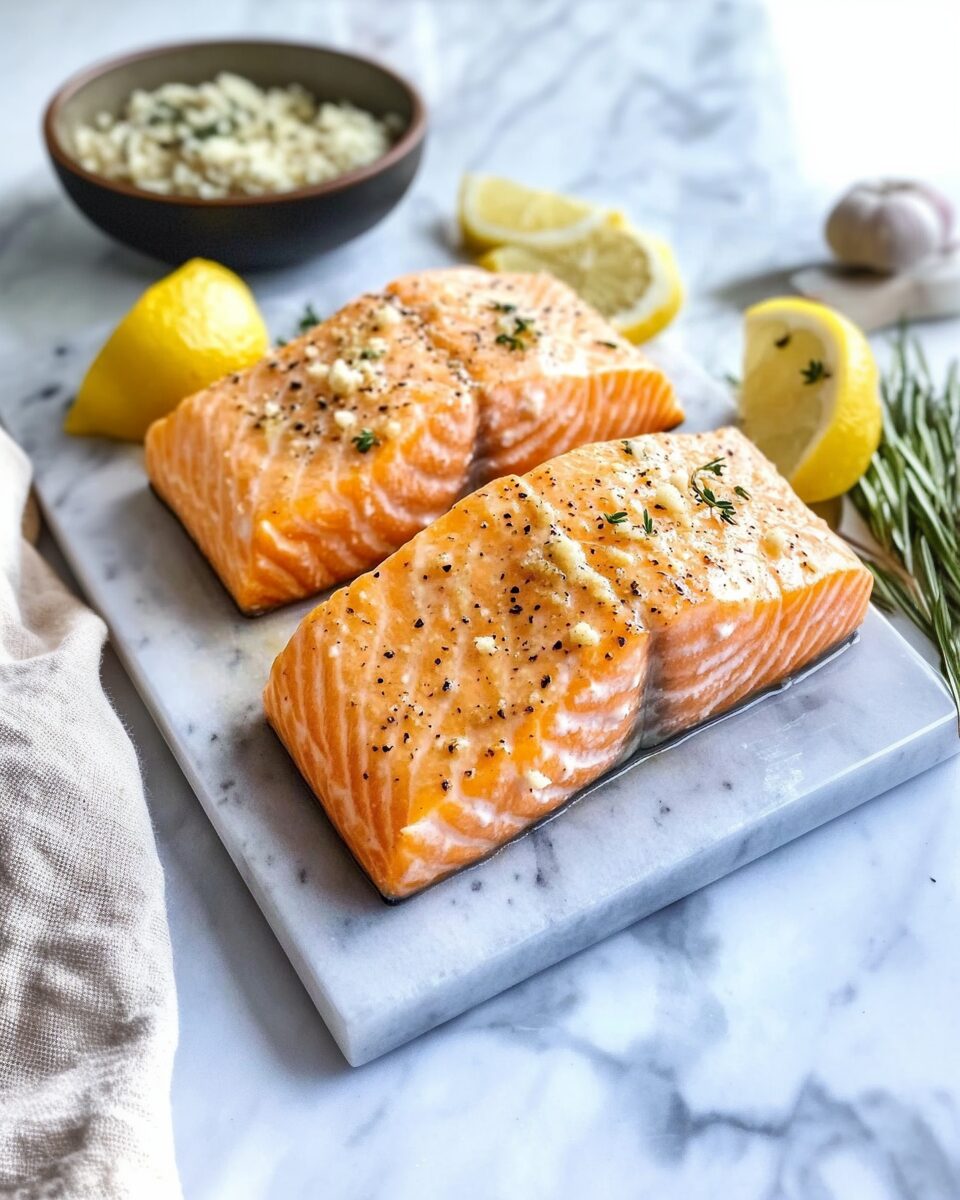If you’re following a ketogenic diet and seeking a flavorful, nutrient-dense meal, this Healthy Keto Salmon recipe is an excellent choice. Salmon is rich in heart-healthy omega-3 fatty acids and high-quality protein, making it ideal for maintaining ketosis. This versatile dish can be prepared using various cooking methods, ensuring a delicious and satisfying low-carb meal.
Full Recipe:
Ingredients
-
Salmon Fillets:
-
Opt for wild-caught salmon for its superior flavor and omega-3 content.
-
-
Olive Oil or Avocado Oil:
-
These healthy fats are perfect for cooking and enhancing the salmon’s richness.
-
-
Garlic:
-
Freshly minced garlic adds aromatic depth without additional carbs.
-
-
Lemon:
-
A squeeze of fresh lemon juice brightens the dish with a refreshing tang.
-
-
Fresh Herbs (Parsley, Dill, or Thyme):
-
These herbs complement the salmon’s flavor; use dried herbs if fresh ones aren’t available.
-
-
Salt and Pepper:
-
Essential seasonings to enhance the natural taste of the fish.
-
-
Optional:
-
Dijon Mustard or Coconut Aminos:
-
Adds a unique depth to the marinade for extra zing.
-
-
Directions
-
Preparing the Salmon:
-
Select fresh, high-quality salmon fillets and pat them dry with a paper towel to ensure even cooking.
-
Season both sides generously with salt and pepper. For added flavor, consider using garlic powder, onion powder, or paprika.
-
Drizzle with olive oil or avocado oil to help the seasoning adhere and provide a suitable cooking base.
-
-
Cooking Methods:
-
Baked Keto Salmon:
-
Preheat the oven to 400°F (200°C).
-
Place the seasoned salmon fillets on a baking sheet lined with parchment paper or aluminum foil.
-
Bake for 12-15 minutes, depending on the fillet’s thickness, until the salmon flakes easily with a fork.
-
For crispier edges, broil for an additional 2-3 minutes.
-
-
Grilled Keto Salmon:
-
Preheat the grill to medium-high heat and lightly oil the grates.
-
Place the salmon skin-side down on the grill.
-
Grill for 4-5 minutes per side, or until the internal temperature reaches 145°F (63°C).
-
Handle the fillets carefully when flipping to prevent breaking.
-
-
Pan-Seared Keto Salmon:
-
Heat a tablespoon of olive oil in a non-stick skillet over medium-high heat.
-
Place the salmon fillets skin-side down and cook for 4-5 minutes.
-
Flip the fillets carefully and cook for an additional 3-4 minutes, or until cooked through.
-
-
-
Serving Suggestions:
-
Garnish the cooked salmon with freshly chopped herbs and a squeeze of lemon juice for enhanced flavor.
-
Pair with keto-friendly sides such as steamed vegetables, cauliflower rice, or a fresh green salad to complete the meal.
-
Nutrients
While specific nutritional information may vary based on portion sizes and exact ingredients used, a typical serving of this Keto Salmon recipe (approximately 6 ounces of salmon) provides:
-
Calories: 367 kcal
-
Protein: 34g
-
Total Fat: 22g
-
Saturated Fat: 3g
-
Monounsaturated Fat: 8g
-
Polyunsaturated Fat: 9g
-
-
Omega-3 Fatty Acids: 4g
-
Carbohydrates: 0g
-
Fiber: 0g
-
Sugars: 0g
-
-
Cholesterol: 94mg
-
Sodium: 75mg (varies based on added salt)
-
Potassium: 780mg
-
Vitamin D: 570 IU (71% DV)
-
Vitamin B12: 4.9 mcg (204% DV)
-
Selenium: 52 mcg (95% DV)
The Nutritional Powerhouse of Salmon
Salmon is one of the most nutrient-rich foods you can consume. It is high in protein, packed with omega-3 fatty acids, and delivers a wide variety of vitamins and minerals that are essential to optimal health. Unlike many other protein sources, salmon contains zero carbohydrates, making it ideal for a ketogenic lifestyle.
Omega-3 Fatty Acids and Cognitive Health
One of the key components that sets salmon apart is its rich content of omega-3 fatty acids—especially DHA (docosahexaenoic acid) and EPA (eicosapentaenoic acid). These fats are critical to brain function and structure. DHA is a fundamental building block of the brain, and regular consumption can enhance cognitive performance, improve memory, and reduce the risk of mental decline as we age.
Heart Health and Inflammation
The heart-health benefits of salmon are well-documented. Omega-3 fatty acids help reduce systemic inflammation, lower triglyceride levels, and improve HDL (good) cholesterol. They also play a role in reducing blood pressure, supporting circulation, and decreasing the likelihood of plaque buildup in arteries.
Rich in Vitamin D and Bone Health
Salmon is one of the few natural dietary sources of vitamin D, a nutrient essential for calcium absorption and bone strength. Vitamin D deficiency is common, especially in areas with limited sunlight, and can lead to bone thinning, fatigue, and compromised immune function. One serving of salmon can provide over half of the daily recommended intake of vitamin D, making it a valuable addition to the keto diet.
Potassium and Electrolyte Balance
Maintaining electrolyte balance is crucial on a keto diet, especially during the initial stages when water loss leads to the depletion of sodium, potassium, and magnesium. Salmon naturally contains a high amount of potassium, which supports muscle contractions, nerve signaling, and fluid balance. Adding salmon to your weekly rotation helps ensure you’re getting enough potassium to avoid symptoms like fatigue, cramps, and weakness often associated with “keto flu.”
Selenium and Antioxidant Protection
Salmon is also rich in selenium, a trace mineral that functions as a powerful antioxidant. Selenium protects your body from oxidative stress and supports immune function, thyroid health, and DNA synthesis. A single serving of salmon typically contains more than 70% of the recommended daily intake for selenium, making it a simple way to bolster your body’s natural defenses.
Why Salmon is Perfect for the Keto Diet
The keto diet is built around the principles of low carbohydrate intake, moderate protein, and high fat. Salmon fits this profile perfectly. It delivers a solid hit of protein, a generous amount of healthy fats, and no carbs. Unlike lean meats that may not provide enough fat for keto macros, salmon contributes to fat intake without the need for excessive added oils or sauces.
Flavor and Versatility
Salmon is incredibly adaptable to a range of cooking methods and flavors, which makes it perfect for avoiding food fatigue. Whether you prefer it grilled, baked, pan-seared, poached, or even raw in dishes like sashimi or keto-friendly sushi bowls, salmon fits the bill.
Its natural richness pairs beautifully with lemon, dill, garlic, butter, olive oil, capers, mustard, and a range of herbs and spices. You can create new experiences each time you cook with it—going from Mediterranean to Asian to classic American flavor profiles with ease.
Keto-Friendly Pairings
To make a complete keto meal, pair salmon with low-carb vegetables and healthy fats. Roasted asparagus, sautéed spinach, or mashed cauliflower make excellent sides. Drizzling your salmon with a creamy garlic butter sauce or a dollop of herbed mayonnaise boosts flavor while keeping you within your macros.
Meal Prep and Batch Cooking
For those who lead busy lives, salmon is excellent for meal prepping. You can prepare several fillets in advance and store them in the fridge for up to three days. Cold salmon works beautifully in salads, wraps (using lettuce leaves or keto tortillas), or even chopped into scrambled eggs.
Sourcing and Sustainability
When selecting salmon, it’s important to consider both nutrition and sustainability. Wild-caught salmon, such as sockeye, coho, and king varieties, tends to have higher omega-3 levels and a firmer texture. Farmed salmon is widely available and more affordable but can vary in quality depending on the farming practices.
If sustainability is important to you, look for certifications like MSC (Marine Stewardship Council) or check if the source practices responsible aquaculture. Choosing high-quality salmon not only enhances the taste but also ensures you’re getting the full spectrum of nutrients with minimal contaminants.
Addressing Common Concerns
Many people worry about mercury or toxin levels in fish. Thankfully, salmon is one of the lowest-mercury seafood options available, especially when compared to species like tuna or swordfish. Its benefits far outweigh potential risks, especially when consumed in moderation as part of a varied diet.
Others may be concerned about the cost of salmon. While it can be pricier than other proteins, the health benefits and versatility it offers make it a worthy investment. Shopping in bulk, buying frozen fillets, or sourcing from wholesale stores can significantly reduce costs.
How Often Should You Eat Salmon on Keto?
For optimal benefits, aim to eat salmon at least two to three times per week. This frequency supports heart and brain health, helps meet protein needs, and supplies vital micronutrients. However, you can easily include it more often without concern—as long as you vary your cooking methods and pairings to keep things interesting.
Cultural and Global Influence of Salmon in Keto
Salmon has long been a part of various traditional diets, from Japanese and Scandinavian to Alaskan and Pacific Northwest cuisines. These cultures have historically enjoyed salmon for its health-promoting properties and rich flavor. With the rise of the keto diet, salmon has experienced a resurgence in global popularity. Recipes now range from keto teriyaki salmon bowls to salmon-stuffed avocados and salmon cakes with almond flour.
Conclusion
Salmon is more than just a delicious fish—it’s a cornerstone of a nutritious keto diet. With its high protein content, healthy fats, essential nutrients, and versatile cooking potential, it checks every box for keto enthusiasts. Whether you’re focused on weight loss, improving brain function, supporting heart health, or simply enjoying satisfying meals, salmon can help you reach your goals while delighting your palate.






